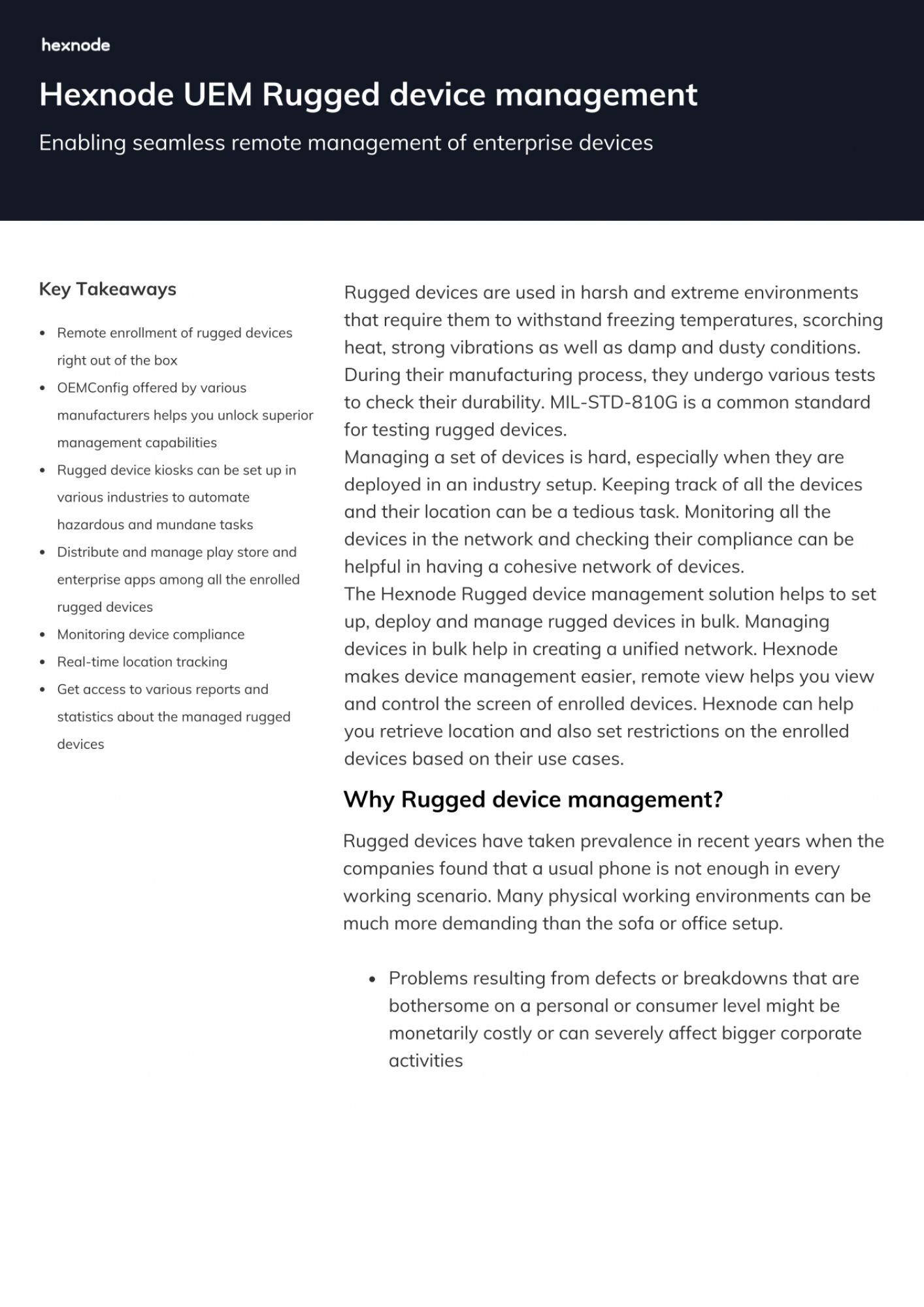2021 has seen a steady rise in the use of rugged devices in order to maintain and even increase operational efficiency. In industries with dangerous equipment present which could cause considerable damage to the devices deployed, the rugged device market has made its mark. Industries like retail, manufacturing, healthcare and military stand to gain the most from this rise in demand. With their unique design and industrial advantages, the durability of rugged devices has become critical in the difficult weather conditions and rugged terrains the workforce is sent to work in.
If you look at the statistics, the future of rugged device management looks very bright. In a study conducted by Technavio in 2020, it was forecast that the rugged device market would grow by USD 1.67 billion and record a CAGR of 5.42% during 2020-2024. As we enter the year 2022, those numbers are only going one way: up.
Increased demand and supply
Industries such as retail, manufacturing, logistics, healthcare and military have become increasingly mobile, with workers continually on the move. These devices deployed to employees will endure difficult weather conditions and a rugged environment which would easily damage a consumer device.
The demand for rugged devices has increased in the last few years, especially with industries looking for remote solutions to increase efficiency. The number of use cases and possibilities for rugged devices has only increased, and it is evident that rugged devices will become more powerful and embed itself in companies’ core business infrastructure.
In the past, the majority of rugged devices ran on Windows Embedded operating systems and were limited in terms of usability and functionality. Today, the market provides for cheaper and easy-to-use options which provide workers a consumer-like experience. Making these devices easy to use improved demand and helped workers get the best out of them.
User expectations drive the evolution of rugged devices and will continue to do so. Sleeker devices, enhanced security capabilities, streamlined automated manageability, integration with other devices like IoT endpoints are features that are expected to become more common in rugged devices.
Crunching the numbers
With the reliance on rugged devices reaching new heights over time, any loss of performance of these devices ends up in loss of productivity for workers as well. In order to maintain them and maintain their levels of performances, IT departments have started to use data analytics to provide more insight and increase proactivity.
Mission-critical apps that run on rugged devices must be given equal importance. These apps are typically custom-made, expensive, and complex. Analytics provide the visibility IT needs to optimize app performance, quickly resolve issues, reduce escalations, and improve the user experience. With robust analytics for both devices and apps, you can predict and solve problems before they happen, providing reliability users can count on when they need it most.
Enhanced Rugged Device Capability: Must-Have
With rugged devices becoming more mission-centric and widely-used across several geographies, enterprises have begun to rethink the traditional device management approach. The solution was to transition towards a more unified management process with a tool of advanced capabilities in order to facilitate the proliferation of more endpoints. IT departments will be able to monitor and manage devices round the clock and increase efficiency at a substantial rate.
Enhanced rugged device capabilities offer a much more enhanced experience for users with features such as:
- a more rapid, streamlined enrollment process.
- simple profile switching which enables employees using the same rugged device to switch configurations easily and remote commands.
- tools that help automate certain actions in order for overall processes to run quickly and efficiently;
The end result: business operations can be done at a rapid rate while producing better results.
New player in the game
In 2018, Microsoft called curtains on the Windows Embedded Handheld and Windows CE operating systems, which was a popular choice for rugged device management in the past decade. Enterprises were forced to upgrade their OS to Windows 10 or migrate to another OS. Android soon became a major player in the rugged device market.
It’s almost 2022 now and Android Enterprise is now viewed upon as the preferred choice for organizations trying to implement a successful rugged device deployment strategy. The battle between Windows and Android has been all but settled. The King is dead, long live the King.
The modern device management capabilities offered by Android OS has seen enterprise productivity levels rise to an unfathomable extent. With the introduction of various other factors like Artificial Intelligence and IoT coupled with how Android OS evolves in the future, Android wouldn’t just dominate the rugged device market, it could become the market itself. To learn more about how and why Android has taken over the rugged device market, take a look at Astrid Wolff’s piece on Android rugged device management.
Rugged devices are most useful in harsh and remote environments. Unlike everyday use devices, they are built for particular purposes. So, it is important that a management suite catering to their specific needs is used.

Featured resource
Hexnode UEM Rugged Device Management
IoT and Rugged Devices
The Internet of Things (IoT) describes the network of physical objects— “things”— that are embedded with sensors, software, and other technologies for the purpose of connecting and exchanging data with other devices and systems over the internet. All the devices you can think of, connected in one digital space. IoT has begun to revolutionize and slowly shape the digital world as we know it. Industries can only stand to gain from such a concept.
To quote an article from Forbes, “IoT solutions designed to help companies predict and react to disruption from many different sources will undoubtedly continue to be a source of major innovation throughout 2022 and beyond.”
The change that rugged device management has brought to various industries in terms of security and productivity is evident at this point. However, you pair IoT and rugged device management together and you get a different beast. Employees and workers can stay connected constantly 24/7 even in the most difficult environments.
The ruggedization of the IoT market has led to astonishing levels of productivity, efficiency and of course, revenue. The integration of IoT with rugged devices is a huge step in the campaign for business operations in major industries becoming completely automated. We’re not quite there yet, but we’re getting there, and IoT will most definitely be a huge part of the evolution for the forseeable future.
Manage your rugged devices with Hexnode UEM
Improve your rugged device management capabilities with Hexnode UEM.
Tap to sign upDigital Transformation: The next step to perfection
An organization looking to improve its operations to a near perfect state of efficiency will most definitely be taking a look at a fully digital version of their operational infrastructure. Rugged device management is just the start of it all. With the introduction and implementation of IoT in core business operations along with Artificial Intelligence, companies will fully embrace modern operational trends, improving efficiency and productivity, communication and a vastly superior form of customer engagement.
Rugged device management has had a good few years at the forefront of business operations. The future of rugged device management sees it take another step further to becoming its very core.

